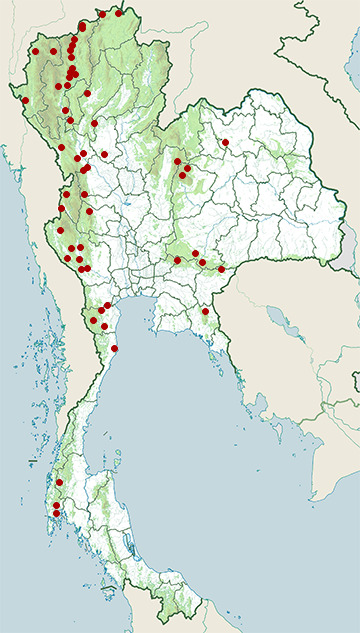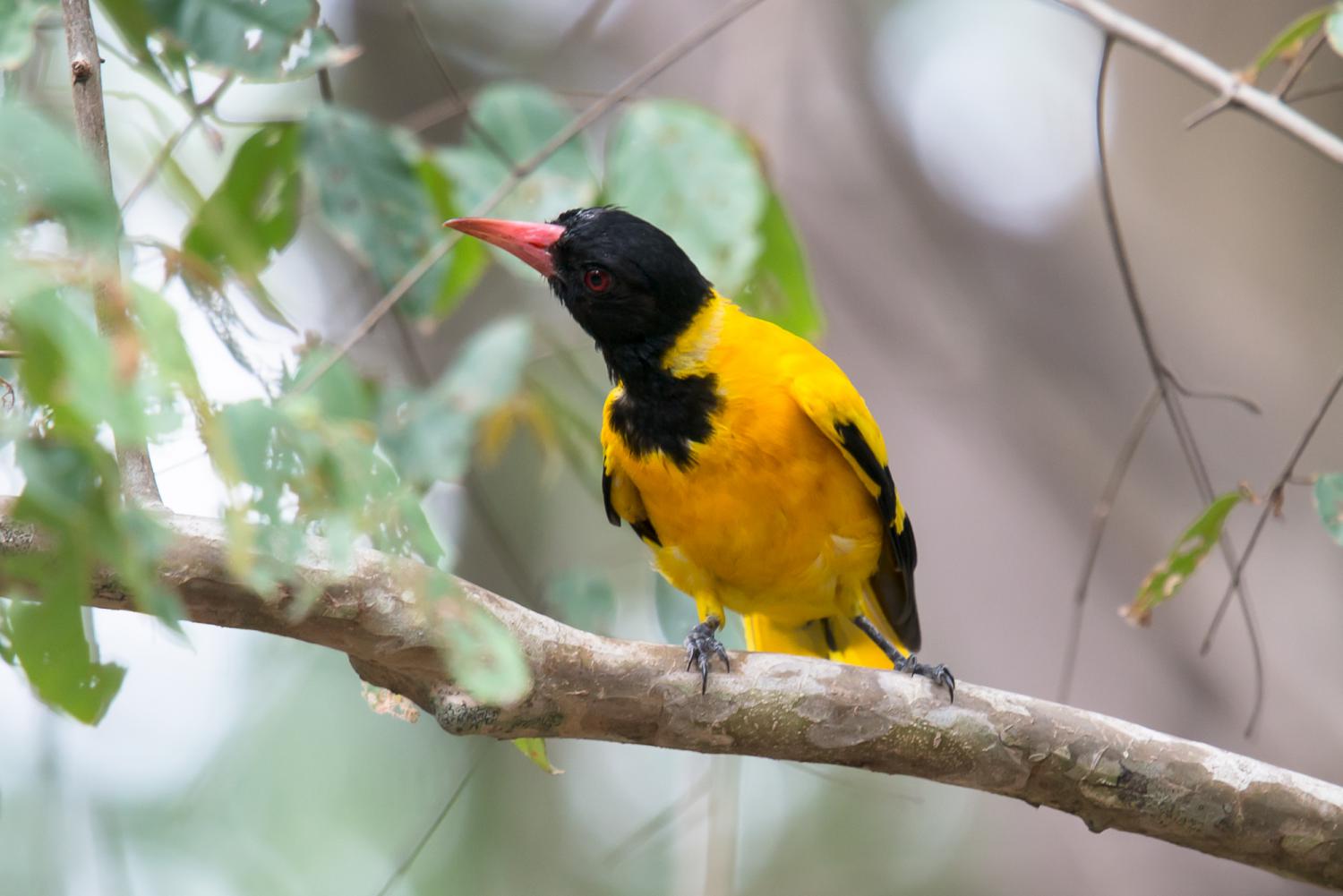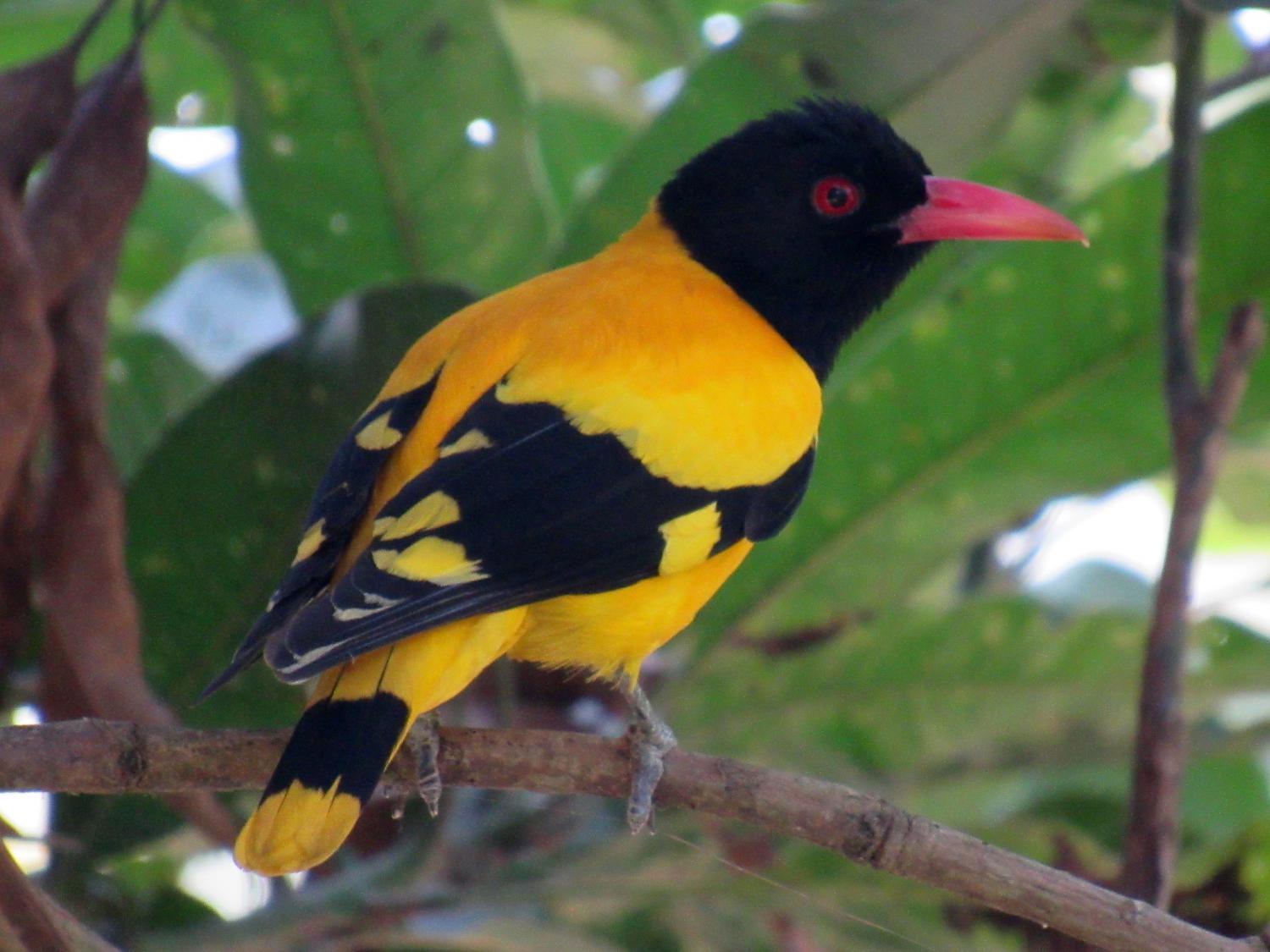Species of Thailand
Black-hooded oriole
Oriolus xanthornus
Carolus Linnaeus, 1758
In Thai: นกขมิ้นหัวดำใหญ่
The black-hooded oriole (Oriolus xanthornus) is a member of the oriole family of passerine birds and is a resident breeder in tropical southern Asia from India and Sri Lanka east to Indonesia.
It is a bird of open woodland and cultivation. The nest is built in a tree, and contains two eggs. Its food is insects and fruit, especially figs, found in the tree canopies where they spend much of their time.
Taxonomy and systematics
The black-hooded oriole was formally described by the Swedish naturalist Carl Linnaeus in 1758 in the tenth edition of his Systema Naturae under the binomial name Coracias xanthornus. Linnaeus was confused by the similar appearance of the unrelated New World orioles and the Old World orioles. In his entry for Coracias xanthornus he cited a descriptions of birds occurring in Jamaica by Mark Catesby and Patrick Browne as well as an illustration by George Edwards of a bird occurring in Bengal. Linnaeus specified the habitat as "America" but Bengal is now the recognised type location. Also in the 10th edition Linnaeus listed Sturnus luteolus among the starlings and cited another illustration by Edwards. He renamed this species as Oriolus melanocephalus in the 12th edition of 1766. All three binomial names are now believed to refer to the black-hooded oriole.
The current genus Oriolus was erected by Linnaeus in 1766 in the twelfth edition of his Systema Naturae. The name is from Medieval Latin oryolus for the Eurasian golden oriole which in turm comes from the Latin word aureolus for "golden". The specific epithet xanthornus is from the Ancient Greek xanthos "yellow" and ornis "bird".
Alternate names for the black-hooded oriole include the Asian black-headed oriole, black-headed oriole, Indian black-headed oriole and Oriental black-headed oriole.
Subspecies
Five subspecies are recognized:
- O. x. xanthornus - (Linnaeus, 1758): Found from northern India to northern Malay Peninsula and Indochina
- O. x. maderaspatanus - Franklin, 1831: Originally described as a separate species. Found in central and southern India
- O. x. ceylonensis - Bonaparte, 1850: Originally described as a separate species. Found in Sri Lanka
- O. x. reubeni - Abdulali, 1977: Found on the Andaman Islands
- O. x. tanakae - Kuroda, 1925: Found on north-eastern Borneo
Description
The male is striking, with the typical oriole black and yellow colouration. The plumage is predominantly yellow, with a solid black hood, and black also in the wings and tail centre.
The female black-hooded oriole is a drabber bird with greenish underparts, but still has the black hood. Young birds are like the female, but have dark streaking on the underparts, and their hood is not solidly black, especially on the throat.
The black head of this species is an obvious distinction from the Indian golden oriole, which is a summer visitor to northern India. Orioles can be shy, and even the male may be difficult to see in the dappled yellow and green leaves of the canopy.
The black-hooded oriole's flight is somewhat like a thrush, strong and direct with some shallow dips over longer distances.
While foraging the species uses foliage-gleening, wood-gleening, or sallying methods.
Relationship to humans
The black hooded oriole lives in common contact with humans in rural and urban India.
A folk tale from Bengal has it that an unfortunate girl of a merchant family was abused and tortured by her mother-in-law. Troubled by various incidents she smeared herself with turmeric paste and covered herself with a sooty earthen pot and killed herself. A goddess resurrected her as a black hooded oriole and a Bengali name for the bird is "benebou" or merchant's wife while another name is "haldi pakhi" or turmeric bird.
This article uses material from Wikipedia released under the Creative Commons Attribution-Share-Alike Licence 3.0. Eventual photos shown in this page may or may not be from Wikipedia, please see the license details for photos in photo by-lines.
Category / Seasonal Status
BCST Category: Recorded in an apparently wild state within the last 50 years
BCST Seasonal status: Resident or presumed resident
Scientific classification
- Kingdom
- Animalia
- Phylum
- Chordata
- Class
- Aves
- Order
- Passeriformes
- Family
- Oriolidae
- Genus
- Oriolus
- Species
- Oriolus xanthornus
Common names
- Thai: นกขมิ้นหัวดำใหญ่
Conservation status

Least Concern (IUCN3.1)
Photos
Please help us review the bird photos if wrong ones are used. We can be reached via our contact us page.
Range Map

- Ao Phang-Nga National Park
- Chiang Dao District, Chiang Mai
- Chiang Dao Wildlife Sanctuary
- Doi Inthanon National Park
- Doi Lo District, Chiang Mai
- Doi Pha Hom Pok National Park
- Doi Suthep - Pui National Park
- Doi Tao District, Chiang Mai
- Erawan National Park
- Fang District, Chiang Mai
- Hang Chat District, Lampang
- Huai Kha Khaeng Wildlife Sanctuary
- Kaeng Krachan National Park
- Khao Laem National Park
- Khao Sam Roi Yot National Park
- Khao Sanam Prieng Wildlife Sanctuary
- Khao Soi Dao Wildlife Sanctuary
- Khao Sok National Park
- Khao Yai National Park
- Khao Yoi District, Phetchaburi
- Khlong Wang Chao National Park
- Khon San District, Chaiyaphum
- Khun Phawo National Park
- Lan Sang National Park
- Mae Fa Luang District, Chiang Rai
- Mae Ping National Park
- Mae Rim District, Chiang Mai
- Mae Taeng District, Chiang Mai
- Mae Wong National Park
- Mueang Chiang Mai District, Chiang Mai
- Mueang Phang Nga District, Phang Nga
- Mueang Tak District, Tak
- Nam Nao National Park
- Namtok Mae Surin National Park
- Nong Bong Khai Non-Hunting Area
- Nong Ya Plong District, Phetchaburi
- Op Khan National Park
- Pai District, Mae Hong Son
- Pha Daeng National Park
- Phu Foi Lom National Park
- Phu Khiao Wildlife Sanctuary
- Ramkhamhaeng National Park
- Sai Yok District, Kanchanaburi
- Sai Yok National Park
- Sakaerat Environmental Research Station
- Salak Pra Wildlife Sanctuary
- Salawin National Park
- Si Satchanalai National Park
- Si Sawat District, Kanchanaburi
- Sri Nakarin Dam National Park
- Ta Phraya National Park
- Tha Yang District, Phetchaburi
- Thap Lan National Park
- Thung Yai Naresuan Wildlife Sanctuary
- Umphang Wildlife Sanctuary


